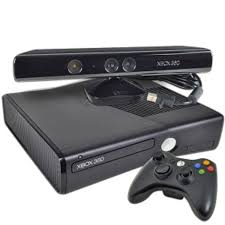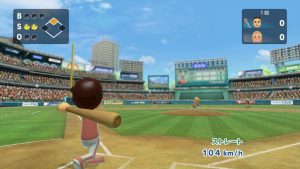Kinect Sports is a digital game that can be purchased for the Microsoft Kinect. Using their body as a controller, players can engage with a range of sports games, including bowling, boxing, golf and tennis. Each of the games can be played individually or as part of a fun group session. Although the objective of each game differs, they all encourage players to undertake some mild physical exercise, develop their hand-eye co-ordination and participate in some friendly competition.
Basic information
Definition:
Kinect Sports Season 1 and Season 2 are a compilation of sports games. The games consist of:
- Season 1- bowling, boxing, track and field, table tennis, soccer and beach volleyball.
- Season 2- golf, darts, baseball, skiing, tennis, American football.
Both games are played on the Xbox 360 and require the use of a Kinect Sensor (which can be purchased separately). This is a motion-sensor technology that enables the player to become the controller. The Kinect monitors a player’s movements and replicates them on-screen through an avatar. Many of the movements are similar to those that would be required to play the real game; resulting in an immersive, life-like gaming experience.
Objectives
Each sports game has its own objectives and these are often similar to that required when playing the real game. An outline of the objectives for some of the games is provided below.
- Bowling: The aim of the main game is to knock down as many pins as possible over ten rounds. People can play alone or compete against up to three other players. Bowling mini games are also available such as Pin Rush, where the player is challenged to knock over as many pins as possible within a time limit.
- Boxing: The aim is to knock-out your opponent through a combination of punches and blocks. People can play alone or compete against one other person.
- Golf: The aim of the game is to hit the ball into the hole. Players can play a maximum of nine holes. The game can be played alone or players can compete against up to four others.
- Tennis: The aim of the game is to score more points than the opponent. Similar to tennis, points are scored by hitting the ball over the net and past the opponent so that it cannot be returned. People can play alone or compete against up to four other people.
Most of the games require an element of physical movement (the amount of movement is dependent on the game selected) as well as attention.
Duration
The length of time required to play will vary depending on the game selected and the number of players. Group games with up to four players will take longer than individual games. Some games such as golf and bowling may also take longer than others due to their slow pace. A typical game with only one player will last somewhere around 15-20 minutes.
Cost:
- The Microsoft 360 and Kinect can be purchased second-hand for around 80 Euros online or brand new for about 180 Euros
- Kinect Sports Season 1 or Season 2 can be purchased second-hand for around 5 Euros online or 20 Euros brand new.
References:
- Explanation for Season 1: https://en.wikipedia.org/wiki/Kinect_Sports
- Explanation for Season 2: https://en.wikipedia.org/wiki/Kinect_Sports:_Season_Two
Development
Participants
Participants’ profile:
- Dementia level: the games can be played by any person although players who have previous experience of playing the games for real are likely to adjust to them quicker than those who have no previous experience.
- Physical requirements:
- Some games such as tennis and American football may require more physical exertion than others such as bowling and golf.
- For some games players will need to be able to swing their arms or their legs.
- Players are able to interact with the game if they are using a walking stick however the Kinect has problems when players are sitting in a wheelchair.
- Some players may require assistance when setting up the games.
Number of participants:
- The number of players depends on the game although it is usually between 1-4 players.
Material and requirements
Materials required to play the game:
- Microsoft Xbox 360.
- Microsoft Kinect Sensor.
- Large television screen.
- The Kinect Sensor can be placed either above the TV or below it on a table.
Environment considerations:
- Good lighting levels. Avoid glare.
- A good amount of space to enable people to move around safely without injuring themselves or others watching.
- People who are not playing the game should be sat away from the playing area. This will mean they avoid getting hit and they will also not interfere with the sensor. If people other than the intended players are in line with the sensor then the game will not work correctly.
- Chairs should be available for people to sit and rest after each turn.
Support needed
Professionals / relatives can:
- Explain the game instructions and their variants.
- Set-up the game by moving through the introduction pages.
- Help players understand the required actions and where to stand in front of the sensor.
Starting point:
- The starting point depends on the games that are being played.
Development:
Instructions on how to play each game depends on the game being used. Details for a few of the popular games that have been used with people with dementia are outlined below.
- Bowling: To begin the game, players reach to their left or right (depending on their hand preference) to take up the bowling ball. Following this, they swing their arms forward to bowl (similar to a typical bowling action). Spin can be added to the ball by exaggerating the arm motion. The aim of the main game is to knock down as many pins as possible over ten rounds. People can play alone or compete against up to three other players. Bowling mini games are also available such as Pin Rush, where the player is challenged to knock over as many pins as possible within a time limit.
For a video demonstration see the following video:
- Boxing: Players swing their left and right arms to punch and block, both at head and body height. The aim is to knock-out your opponent. People can play alone or compete against one other person.
For a video demonstration see: https://www.youtube.com/watch?v=SUMg9Gfu4Qw
- Golf: Players begin by positioning themselves side-on to the screen (either right or left side depending on personal preference). Once side-on, they can determine the ball’s direction of travel by moving either forwards or backwards. This will often be dependent on the location of the hole (indicated on the screen by a white arrow). Once set-up, players move their arms back, before swinging them forward in a smooth motion to hit the ball (similar to swinging a real golf club). The faster they swing, the harder the ball will be hit. On occasions, players will also need to take into account the wind factor, which will be highlighted on the screen, as well as the terrain (whether they are playing from the green, the rough or a sand bunker). The aim of the game is to hit the ball into the hole. People can play alone or compete against up to four other people.
For a video demonstration see: https://www.youtube.com/watch?v=bZXa-X_3MAk
- Tennis: To begin the game, players reach to their left or right (depending on their hand preference) to take up the tennis racket. When serving, players are required to throw the ball in the area using the hand without the racket, and then hit it whilst in the air with their other hand. If players are facing a serve, then they are required to return the ball either through a forehand or backhand shot depending on the travel of the ball. The avatars will automatically move with the ball although players will be required to time their own shots. Hand-eye co-ordination and timing is important for this game, and new players may find it a little difficult to begin with. The aim of the game is to score more points than the opponent. Similar to tennis, points are scored by hitting the ball over the net and past the opponent so that it cannot be returned. People can play alone or compete against up to four other people.
For a video demonstration see: https://www.youtube.com/watch?v=YHDXc566vhU
Additional information
Practical advice
The Kinect Sports Bowling Game is a fun, interactive game that is great for promoting social cohesiveness and friendly competition. With a group of up to 8 people, you can encourage them to join into pairs and work together to knock down all of the skittles during their turn. This way each pair will be competing against the other pairs in the group to obtain the highest score after ten rounds of bowling.
During their turn, one member of the pair will bowl the first ball, and the second member will be responsible for clearing up any pins that may have been missed. It is useful to have each member of the pair switch position on each turn i.e. if one player bowled the first ball during their turn, then the following turn they bowl the second ball. This way everyone will have a chance to engage with the game (particularly if one member of the pair is very good and continues to hit strikes, meaning their partner will not be required during that turn). This is a great way to encourage people to work together and support their partner while they play the game, and promote a wider sense of friendly competition amongst your group. You could also consider introducing a cup that you can present to the winning pair at the end of the game. This will provide players with a sense of achievement, which is important for their well-being and sense of self-esteem.
Variants of the game:
- People can play most games alone; however the games can be arranged so that people play in teams. For instance on the bowling game, one person can bowl the first ball and another can bowl the second ball during each turn. This will encourage players to work together to achieve their aims.
Alternative games:
Similar AD-GAMING games:
Assessment:
- Record the amount of time required by players to correctly interact with the game.
- Record players’ scores.
- Observe and monitor the social interaction amongst the players.
- Observe and monitor the levels of competition amongst the players.
- Dementia Care Mapping tools can be used to record in-the-moment benefits for players when interacting with these games.
Notes / observations
- You can often buy the technological equipment and games for second hand on various websites. They will still work well and are often a lot cheaper than buying the equipment brand new.
Practical activity
Game:
Kinect Sports Golf
Activity:
30 minute game for 8 players
Prepare the game:
Install the Kinect Sports 1 game and select the Kinect Golf game
Set the game up to run with four avatars (players)
Ask the participants to pair-up with a friend or another player. If they do not wish to do this, then this should be carried out by the activity facilitator.
Arrange the chairs in a semi-circle around the TV screen to encourage those not playing to watch
Explanation:
Tell the participants that they will be working in a team of two and competing against the other three teams.
Encourage each player to take turns in hitting the golf ball when it is their pairs turn.
The players can alternate which turn they take. This will ensure that every play has an equal amount of turns.
The winning team is the one that putts the golf ball in as few a shots as possible.
This is a great way to encourage co-operation between team members as well as friendly competition between the group.
Observation:
Facilitators can look out for the co-operation between the team players as well as the competition between the other teams.
Facilitators can encourage the team players to support one another on their turn e.g. help them to line up their shot so that they hit the ball in the correct direction.
Assessment:
Speak to the players and ask them for their feedback on the game and how they felt working together.
Ask them to discuss the difficulty of the game.
![]()




